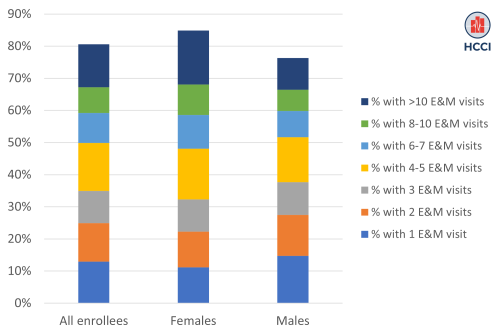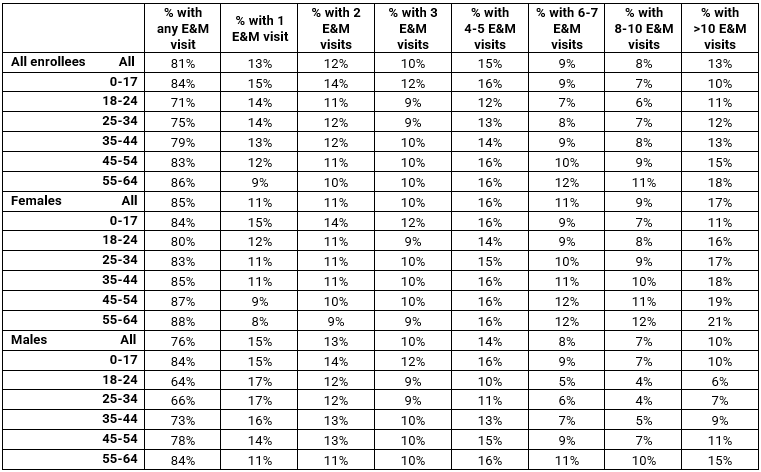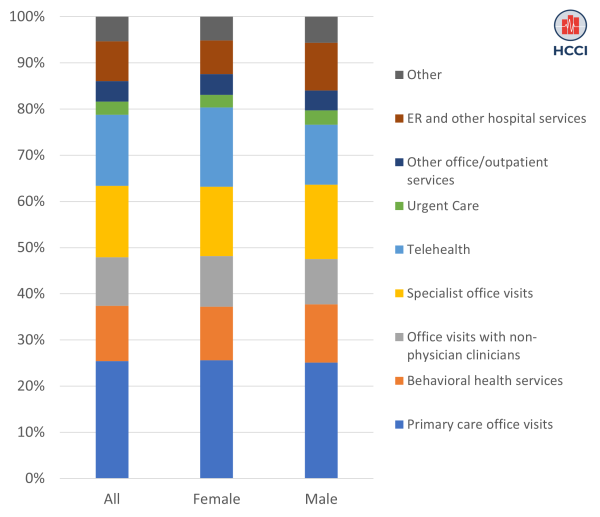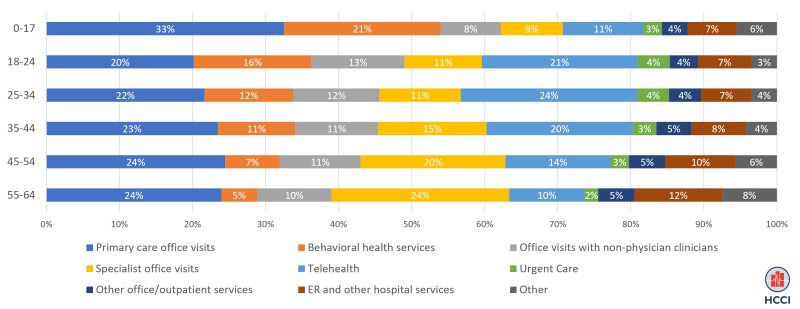All HCCI Reports
Over 80% of ESI Enrollees Used Evaluation and Management Services in 2021, with Primary Care and Telehealth the Most Commonly Used
Evaluation and Management (E&M) services provide an entry point for many people into the health care system. This category of services includes most office visits to a primary care physician or specialist, including behavioral health services, as well evaluation and management services provided in an emergency room or outpatient setting. These visits typically involve a physician or other health care professional diagnosing and treating illness or injury. Nearly all specialties perform E&M services. Among ESI enrollees under age 65 in HCCI's data, E&M services accounted for one-third of all spending on physician and other professional services over the last five years. Here, we use HCCI's dataset of health insurance claims for 50 million Americans with employer-sponsored insurance to take a closer look at how ESI enrollees use E&M services, including differences in use by age and sex and what kinds of E&M services ESI enrollees use most.
Over 80% of ESI Enrollees Used at Least One E&M Service in 2021
In 2021, 81% of ESI enrollees had at least one E&M visit. While 13% of enrollees had just one visit, 15% had 4 or 5 visits, and 13% had more than 10 E&M visits in 2021. As shown in Figure 1, women were more likely to have any E&M visit (85% compared to 76% of men) and more likely to have more visits—17% of women had 10 or more visits compared to 10% of men.
Figure 1. Just Over 80% of ESI Enrollees Used an E&M Service, with Higher Use among Women
Among all enrollees, children (age 0-17) and adults between the ages of 55-64 had the highest shares with at least one E&M service (84% and 86%, respectively). People between the ages of 55-64 were also much more likely to have 10 or more E&M visits (18%) than those in younger age groups. Although 84% of girls ages 0-17 had at least one E&M visit, the same as all children, women aged 45-54 and 55-64 had the highest rates of use. Among women in those age categories, 87% and 88%, respectively had at least one E&M visit and about 20% had more than 10 visits in the year.
Primary Care and Telehealth Made Up over 40% of E&M Visits
Among all enrollees, and for both men and women, over one-quarter of all E&M services were visits with a primary care provider (Figure 2). Overall, telehealth visits accounted for 15% of E&M services; this share was higher for women (17%) than for men (13%). Other common E&M services included specialist office visits (15%), office visits for behavioral health services (12%), and office visits with non-physician clinicians (e.g., nurse practitioners) (10%). E&M visits also included clinician services provided in the hospital and in the emergency room (9%).
Figure 2. Primary Care Visits Made up Just Over 25% of all E&M Services among Women and Men in 2021
Among all enrollees, behavioral health visits made up 12% of all E&M services, however this share was nearly double among children (21%). Together, behavioral health services and primary care visits (33%) made up over half of E&M services among children. In the young adult population (ages 18-34), telehealth visits made up the largest share of E&M visits (21%), potentially reflecting the growth of these services during the COVID-19 pandemic. Primary care office visits accounted for a similar share of E&M visits among this age group (20%). For those ages 35-44, primary care office visits accounted for almost a quarter of visits, followed by telehealth services (20%). Among those over 45, the largest shares of E&M visits were for primary care and specialist office visits.
Figure 3. Share of E&M Visits by Visit Type among HCCI Enrollees by Age, 2021
Evaluation and management services play a number of important roles in the health care system. For many, they are the gateway into the system more broadly, an important setting for building ongoing patient-physician relationships, and the setting where patients receive care for a range of chronic conditions, mental health and other behavioral health needs, and care to prevent future adverse health outcomes. In our recent data, we see evidence of changes in patterns of E&M care with the high share of visits happening via telehealth. (Elsewhere, we document the increases in telehealth primary care and behavioral health services over time and across payers.) Given their high use across all age groups, ensuring equitable, accessible, and high-quality E&M services across specialties and settings will be important going forward.
Methodology
These analyses are based on the professional services files in HCCI's ESI claims data. For Figure 1 and Table 1, our sample consists of ESI members who are continuously enrolled during 2021. We also restricted the sample to members who have the same age category throughout the year and non-missing sex information. Figure 2 and Figure 3 are based on HCCI's Health Care Cost and Utilization Report (HCCUR) downloadable data. We defined evaluation and management (E&M) visits using the detailed categorization of the HCCUR methodology.
When you subscribe to the blog, we will send you an e-mail when there are new updates on the site so you wouldn't miss them.




